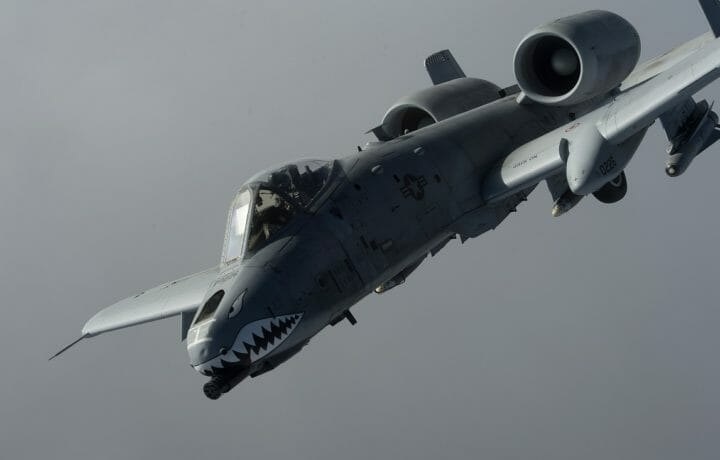Despite years of pressure from lawmakers that forced the United States Air Force to keep the Fairchild Republic A-10 Thunderbolt II in its fleet, the air service is finally beginning to retire the Cold War ground attack aircraft, arguing it is too vulnerable to survive a modern conflict. That has led to calls that the A-10, which has earned the moniker “Warthog,” could be sent to Ukraine.
The rationale has been that the A-10 was initially developed to offset the massive imbalance in the number of tanks that the Warsaw Pact had over NATO during the Cold War. Many military strategists expected a massive invasion of Soviet armor advancing through the Fulda Gap in Germany, and the A-10 was considered ideal for conducting low-level strikes to counter such an invasion.
Yet, even then the heavily-armored A-10 wasn’t expected to survive endless runs against the Soviet-led forces. Modern air defenses have only steadily improved, and that could explain why Kyiv hasn’t called for any of the A-10s that could be soon heading to the “Boneyard,” the more commonly used name of the 309th Aerospace Maintenance and Regeneration Group (309th AMARG). Located at Davis-Monthan Air Force Base (AFB), Arizona, it is where nearly 4,000 out-of-service aircraft from all branches of the U.S. military are stored.
Ukraine Doesn’t Want Them – But Are They the Right Weapon?
Ukraine has pressed for attack aircraft, and it has called for the F-16 Fighting Falcon, an aircraft that Lockheed Martin is still producing with modern upgrades. It seems largely uninterested in the A-10s, however.
“Ukraine hasn’t expressed much interest. I think they, rightfully, are concerned about their survivability,” Air Force Secretary Frank Kendall said during a House Armed Services Committee hearing Wednesday.
Some aviation experts have suggested that the A-10 could still be the right aircraft for Ukraine, as it was designed to survive even after heavy damage, while it can operate from austere airfields. Moreover, the Ukrainian Air Force does operate the far less capable Su-25 (NATO reporting name Frogfoots), a slow-flying ground attack aircraft that has been employed to strike Russian tanks.
The A-10 could be supported by other aircraft – such as the F-16 – to accomplish its mission, which is striking columns of tanks. As recently as last month, the Kremlin has continued to send its armor in columns down narrow roads, and experts say that the Warthog would be ideally suited to making attack runs to counter those attacks.
The aircraft is armed with a unique GAU-8/A Avenger 30mm (1.18-inch) cannon, and during the Gulf War in 1991 proved to be among the most effective anti-tank aircraft ever devised. The 30mm GAU-8/A cannon, which protrudes from the nose of the plane, can fire 3,900 bullets per minute.
“This idea that they wouldn’t be effective on the battlefield in Ukraine, I don’t subscribe to because this plane was literally designed to destroy Soviet armor and Russian armor. Yes, it’s a bit dated, but so are the ATACMS, so are the HIMARS,” Luke Coffey, a senior fellow at the Hudson Institute, told Defense One.
Other U.S. Allies See the A-10s Potential
Even as Kyiv hasn’t pushed for the A-10, Kendall told lawmakers that another U.S. ally was interested in the aircraft. Though he didn’t name the country, there is speculation it could be Poland or Romania – both NATO members that have voiced concerns about what Moscow could do if it succeeds in defeating Ukraine.
The Thunderbolt II has been deployed to both nations in recent years.
“One country at least has expressed some interest, but the problem is once that aircraft goes out of the U.S. inventory, there won’t be any base support for it. So any country that picks it up and tries to sustain it would have a very hard time. It’s also a very old aircraft, about 45 years old. Replacement parts are very hard [to find],” Kendall warned.
Though replacement parts could be an issue, supporters of the A-10 have also warned that the Lockheed Martin F-35 Lightning II, which was designed as a multirole aircraft, may lack some of the close air support (CAS) capabilities of the Warthog. As the delivery of the F-35 to NATO members could be years away, it is easy to see why some NATO members on Russia’s doorsteps may want a proven CAS aircraft while waiting for the more advanced multirole fighter.
In an unthinkable conflict with Russia, NATO will need every aircraft it can get.




